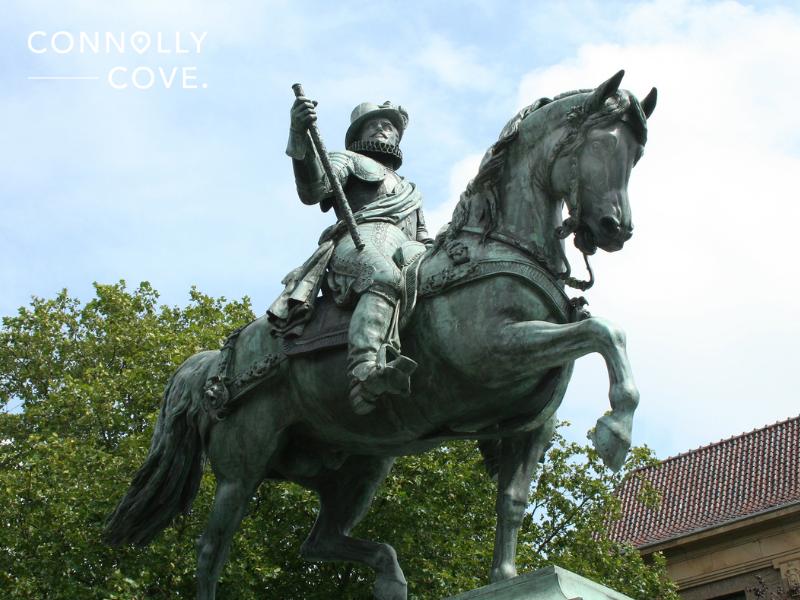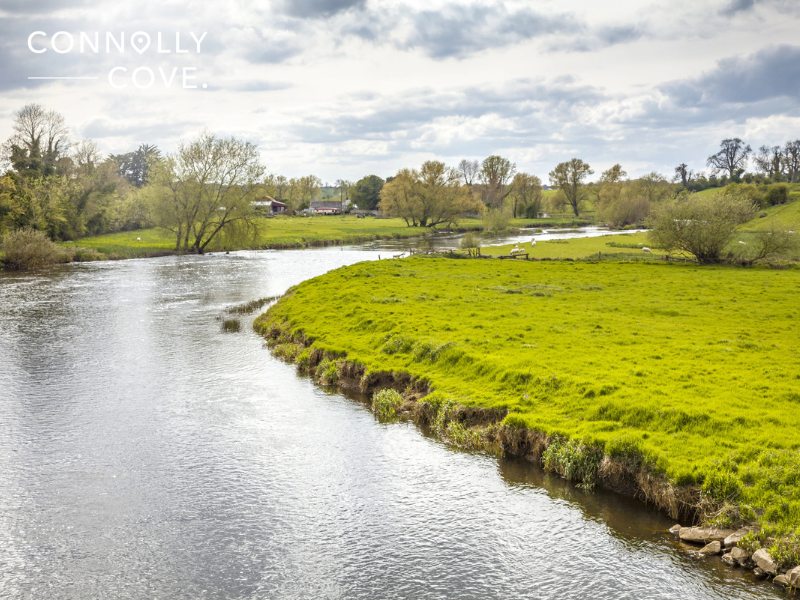The Battle of the Boyne: A Historic Clash and Its Significance

Updated On: April 14, 2024 by Maha Yassin
On a crisp summer day in 1690, the banks of the River Boyne in Ireland witnessed a clash of arms that would forever alter the course of history. Though a single day’s fight, the Battle of the Boyne became a pivotal moment in the struggle for the British crown and in shaping the complex relationship between Ireland and Britain for centuries to come.
This article delves into the events leading up to the battle, the opposing forces that met on the battlefield, and the lasting legacy of this historic encounter.
A Throne in Turmoil: The Road to the Boyne
The thunder of cannons on the banks of the Boyne wasn’t an explosion of violence. It was the culmination of decades of simmering tensions that had finally reached a boiling point. Let’s delve into the complex web of religious divisions, political manoeuvres, and a power struggle that ultimately led to this pivotal battle.
Religious Divide and Shifting Power
The Battle of the Boyne wasn’t an isolated event. It erupted from a long history of religious tensions between Catholics and Protestants in England and Ireland. For centuries, the question of who would rule—a Catholic or Protestant monarch—had been a source of conflict. This tension intensified after the English Reformation in the 16th century, which established the Church of England as the official religion. Catholics faced discrimination and restrictions under Protestant monarchs, fueling resentment and a desire to restore Catholicism.
The Reign of James II and Protestant Discontent
When James II, a Catholic convert, ascended the English throne in 1685, alarm bells rang among the Protestant elite. James’s attempts to promote Catholicism and dismantle longstanding Protestant privileges, such as holding public office, were seen as a threat to the established order. This growing unease fueled fears of a return to a time of Catholic dominance and persecution.
The Glorious Revolution and William of Orange

These anxieties reached a boiling point in 1688. When James II had a son, James Francis Edward, with his second Catholic wife, Mary of Modena, Protestant fears of a Catholic dynasty solidified. A group of influential English nobles, fearing a return to Catholicism, decided to take action. They secretly invited William of Orange, a Protestant leader of the Dutch Republic who was also James II’s son-in-law (married to James’s daughter Mary), to invade England. William, presented with an opportunity to secure the English crown and a powerful ally against France’s growing power in Europe, readily agreed.
James II’s Flight and the Irish Rebellion
Faced with a bloodless invasion and widespread desertion from his army, James II fled to France in December 1688. However, he wasn’t prepared to give up his throne. He saw Ireland’s predominantly Catholic population as a crucial pawn in his plan. Landing there in 1689, James hoped to raise an army and use Ireland as a springboard to retake England. His arrival sparked a bloody rebellion in Ireland, with Catholic mobs targeting Protestant communities throughout the country.
The Stage is Set: William Prepares for War
William of Orange, determined to secure his claim on the British crown and quell the rebellion in Ireland, set sail in 1690 with a well-equipped army. His forces comprised Dutch, English and even Protestant Irish troops united against the threat of a Catholic monarchy. With a hastily assembled force bolstered by French soldiers, James II awaited them on the River Boyne’s banks. The clash was inevitable, and its outcome would have profound consequences for the future of both Ireland and Britain.
Armies on the Brink: The Opposing Forces at the Boyne
The banks of the Boyne became a battleground not just for land but for the very soul of Britain and Ireland. Fueled by religious fervour and political ambitions, two vastly different armies stood poised to clash.
William’s Williamites: A Coalition of Convenience
King William III, leading the Williamite forces, commanded a well-drilled and well-equipped army. The core consisted of seasoned Dutch troops renowned for their battlefield discipline and firepower. Alongside them marched English soldiers, recently sworn to William’s cause, and even Protestant Irish regiments eager to defend their lands and faith. While William enjoyed a clear military experience and weaponry advantage, his army wasn’t unified. Religious and political differences simmered beneath the surface, with some Protestant Irish troops harbouring suspicions of English dominance.
James’s Jacobites: Defending Faith and King
Facing William across the Boyne was King James II’s Jacobite army. Though less well-equipped than their opponents, the Jacobites possessed a sincere loyalty to their exiled king and the Catholic faith. The backbone of James’s army was the Gaelic Irish, eager to overthrow English rule and restore Catholicism as the dominant religion. French military advisors and a contingent of French soldiers bolstered their ranks, adding much-needed experience. However, the Jacobites faced challenges. Their troops were a mix of untrained levies and experienced soldiers, lacking the Williamites’ cohesion. Internal divisions existed between the Irish and French, with some mistrust evident.
A Clash of Ideals: More Than Just a Battlefield
The Battle of the Boyne wasn’t simply a fight between two armies; it represented a clash of ideologies. William’s forces fought for a Protestant monarchy and continued English dominance in Ireland. On the other hand, the Jacobites battled for a Catholic king, Irish self-determination, and the restoration of their faith. The outcome of this battle would determine who ruled and shaped Ireland’s religious and political landscape for centuries to come.
A Clash on the Boyne: The Tumultuous Course of the Battle

On a crisp summer morning in July 1690, the emerald fields of Ireland witnessed a pivotal moment in history. The opposing forces – William’s well-drilled Williamites and James’s passionate Jacobites – converged on the banks of the River Boyne near Drogheda. Here, under a clear sky, a fierce battle erupted, forever etching its mark on the memories of both nations.
Setting the Stage: The Landscape of War
The battlefield itself played a crucial role in the events that unfolded. The River Boyne, though not wide, presented a significant obstacle for William’s army. Aware of this advantage, the Jacobites positioned their forces along the southern bank, utilising hedgerows and stone walls for cover. Determined to force a crossing, William established his cannons on the northern bank to soften the Jacobite defences.
The Tide Turns: A Day of Fury
The battle commenced with a thunderous roar as William’s cannons unleashed a barrage on the Jacobite lines. Smoke filled the air, and the earth trembled under the relentless pounding. The Williamites then attempted to ford the river, but they were met with a fierce hail of musket fire from the Jacobites. The initial crossing was bloody, with many Williamites falling victim to the withering defensive fire.
A Moment of Crisis: William Takes Charge
Seeing his troops’ initial faltering, William rode into the fray, rallying his men and leading a daring charge across the Boyne. This leadership show inspired the Williamites, who pressed their attack with renewed vigour. The battle became a brutal melee, with musket fire punctuated by the clash of steel on steel. Though outnumbered, the Williamites’ superior training and discipline gradually began to show.
The Jacobites Falter and Flee
The turning point came when James II, witnessing the ferocity of the Williamite assault, panicked and fled the battlefield. This demoralised the Jacobite forces, and their resolve was fractured. With their king gone, the Jacobites broke ranks and retreated in disarray. William’s forces pressed their advantage, securing victory on the banks of the Boyne.
A Costly Victory: The Aftermath of the Battle
Though William emerged victorious, the Battle of the Boyne was far from a bloodless triumph. Both sides suffered heavy casualties, with the verdant fields stained crimson. While the battle effectively shattered James II’s hopes of regaining the throne, it did not mark the end of the conflict in Ireland. The war would drag on for another year, culminating in the Treaty of Limerick in 1691. However, the Boyne remained pivotal, setting the stage for centuries of Protestant dominance in Ireland.
Echoes of the Boyne: A Legacy of Division and Domination

The cannons may have fallen silent on the banks of the Boyne, but their echoes reverberated far beyond the battlefield. While William of Orange won the battle, its outcome had far-reaching consequences that shaped Ireland’s religious and political landscape for centuries.
A Pyrrhic Victory: William Claims the Prize
While William secured a decisive victory, it came at a significant cost. Casualties were high on both sides, and the grim reality of the battlefield tempered the jubilation of triumph. However, William wasted no time in exploiting his advantage. He marched on Dublin, which surrendered with little resistance. This effectively solidified his control over much of eastern Ireland.
The War Continues: The Irish Resolve
Despite the setback at the Boyne, the Jacobite resistance wasn’t crushed. Though shaken, James II fled to France and continued plotting his return. The remaining Jacobite forces regrouped in the west of Ireland, where they enjoyed greater support from the Catholic population. The war would drag on for another year, culminating in the bloody and decisive Battle of Aughrim in 1691. However, the Boyne served as a psychological turning point, shattering the myth of Jacobite invincibility.
A Protestant Ascendancy: The Long Shadow of the Boyne
The aftermath of the Williamite victory ushered in a period of Protestant dominance in Ireland. The Penal Laws, a series of discriminatory measures enacted by the Protestant Parliament, aimed to curtail the Catholic population’s political and economic power. Land ownership shifted dramatically, with many Catholic landowners dispossessed and their lands granted to Protestant settlers. This period of repression fueled resentment and contributed to the sectarian divisions that would plague Ireland for centuries.
A Divided Legacy: The Battle in Modern Ireland
The Battle of the Boyne remains a contentious issue in modern Ireland. For Unionists, descendants of Protestant settlers, it represents a victory against tyranny and a symbol of their historical connection to Britain. For Irish nationalists, particularly those of Catholic descent, it signifies a crushing defeat and the beginning of a long period of oppression. This contested legacy continues to be debated and commemorated in different ways by the various communities within Ireland.
A Pivotal Moment in History: Beyond the Battlefield
Despite its controversial nature, the Battle of the Boyne holds undeniable historical significance. It marked a turning point in the struggle for the British crown and the relationship between England and Ireland. The Protestant ascendancy established after the Boyne profoundly impacted Irish society, shaping its demographics, politics, and cultural identity. While the battle itself may have been a single day’s fight, its legacy continues to resonate in the complexities of modern-day Ireland.
Exploring the Battle of the Boyne Beyond the Text
The complexities and lasting impact of the Battle of the Boyne can be further explored through various resources in Ireland and beyond. Here are some avenues to delve deeper, with a specific focus on museums in Ireland:
Battle of the Boyne Visitor Centre (Oldbridge, County Meath)
Located on the grounds of Oldbridge House, a restored 18th-century residence, this visitor centre offers the most immersive experience related to the battle. Here, you can:
- Explore interactive displays that bring the events of the Boyne to life, including a detailed battlefield model with troop movements and key moments highlighted.
- You can view a collection of original weapons and military equipment used during the battle, providing a tangible connection to the soldiers involved.
- Learn about the lives of the key figures on both sides of the conflict, gaining a deeper understanding of their motivations and strategies.
- Walk the battlefield, following designated trails showcasing the strategic layout and terrain that played a crucial role in the battle’s outcome.
National Museum of Ireland – Decorative Arts & History (Dublin)
While not solely dedicated to the Battle of the Boyne, this expansive museum in Dublin houses a significant collection of artefacts that offer valuable insights into the period. You can find:
- Warlike items like swords, pistols, and muskets provided a glimpse into the weaponry used by the Williamite and Jacobite forces.
- Clothing and personal effects from the 17th century help you visualise the soldiers and everyday life during this period.
- Historical portraits and maps can shed light on the political landscape and key figures involved in the conflict.
Ulster Museum (Belfast)

Located in Northern Ireland, the Ulster Museum offers a unique perspective on the Boyne and the Williamite War, particularly its impact on the north of Ireland. Here, you can explore:
- Exhibits that delve into Ulster’s social and political climate in the 17th century highlight the complex religious and ethnic divisions that existed.
- Artefacts related to the war’s impact on Ulster, including weaponry, documents, and personal accounts from those who lived through the conflict.
- Displays exploring the long-term consequences of the Boyne on Northern Ireland’s development and ongoing sectarian tensions.
These museums provide valuable starting points for understanding the Battle of the Boyne and its lasting influence. Each offers a unique perspective, allowing you to create a more comprehensive picture of this pivotal moment in history.
A Clash of Titans: The Enduring Legacy of the Boyne
The Battle of the Boyne, though a single day’s fight, reverberates through the corridors of history like a thunderclap. It wasn’t just a clash of armies but a collision of ideologies, religions, and claims to power. William of Orange emerged victorious, securing the British crown and consolidating Protestant dominance in Ireland. Yet, the battle’s legacy is far from simple.
For Unionists, it symbolises triumph, a moment of defying tyranny and securing their place in Ireland. For Irish nationalists, particularly those of Catholic descent, it represents a crushing defeat and the beginning of a long period of oppression. This contested legacy continues to be debated and commemorated in various ways, reflecting the enduring divisions within Irish society.
Despite the controversy, the Battle of the Boyne’s historical significance is undeniable. It marked a turning point in the struggle for the British crown and the relationship between England and Ireland. The Protestant ascendancy established after the Boyne profoundly impacted Irish society, shaping its demographics, politics, and cultural identity.
The thunder of cannons on the banks of the Boyne may have faded centuries ago, but its echoes continue to resonate. By exploring the battle’s complexities, participants’ motivations, and long-term consequences, we gain a deeper appreciation for the forces that continue to shape the modern world. The Battle of the Boyne serves as a potent reminder of the enduring power of history and the importance of understanding the past to navigate the complexities of the present.






